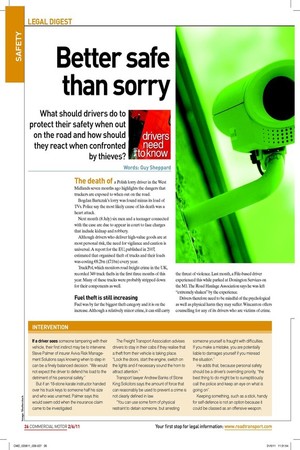INTERVENTION
Page 23

Page 24

If you've noticed an error in this article please click here to report it so we can fix it.
If a driver sees someone tampering with their vehicle, their first instinct may be to intervene. Steve Palmer of insurer Aviva Risk Management Solutions says knowing when to step in can be a finely balanced decision. “We would not expect the driver to defend his load to the detriment of his personal safety.” But if an 18-stone karate instructor handed over his truck keys to someone half his size and who was unarmed, Palmer says this would seem odd when the insurance claim came to be investigated. The Freight Transport Association advises drivers to stay in their cabs if they realise that a theft from their vehicle is taking place. “Lock the doors, start the engine, switch on the lights and if necessary sound the horn to attract attention.” Transport lawyer Andrew Banks of Stone King Solicitors says the amount of force that can reasonably be used to prevent a crime is not clearly defined in law.
“You can use some form of physical restraint to detain someone, but arresting someone yourself is fraught with difficulties. If you make a mistake, you are potentially liable to damages yourself if you misread the situation.” He adds that, because personal safety should be a driver’s overriding priority, “the best thing to do might be to surreptitiously call the police and keep an eye on what is going on”.
Keeping something, such as a stick, handy for self-defence is not an option because it could be classed as an offensive weapon. Dave Rowlands, Wincanton technical services director, explains: “It can affect people in very different ways.”
Suspicious behaviour
One obvious preventative measure is to watch out for suspicious behaviour. DS Sue Coutts of Truckpol says that drivers who suspect they are being followed should go to the nearest well-lit area, where there are plenty of other people, and then contact the police.
“If you can, take note of the registration of the suspicious vehicle,” she says. “You can always pull in and pull out again to see if they are still following you.” At Irvine-based Maxi Haulage, drivers are instructed to contact the police about anything they feel is suspicious, including when someone is wandering around parked trucks for no apparent reason.
Training manager Carl Jeffs instructs drivers to insist on seeing an identity card if someone knocks on their cab door. “They should inspect it and, if not satisied, stay in their cab. It’s not like the old days when you would get out and help each other.”
Bogus officials
If ordered to stop by the occupants of what appears to be an unmarked police car, there are tell-tale signs that indicate whether they are fakes.
Coutts says the car is usually genuine if there is an electronic message board on the back shelf telling the driver to pull over. “If it was on the motorway, police would normally take them to the next junction or service area. “Police vehicles generally have a couple of aerials and are likely to have blue lights itted to the grills and bumpers. Bogus oficials tend to wear high-visibility jackets rather than police uniform.” She advises anyone feeling suspicious of someone claiming to be an oficer to phone the police to check their identity.
Another precaution is to keep windows closed and doors locked when approached and to only open them after reaching the protection of the police station.
One well-known scam is for a bogus oficial to try to divert the driver to an alternative delivery address. It is vital for drivers to check with their trafic ofice for veriication in order to prevent this.
Parking
The choice of overnight parking site has a big impact on the likelihood of crime. Last year, the Logistics Security Network published a survey showing that nearly half of drivers who park in insecure locations had been victims of crime. Curtain slashing and fuel theft were the most common types of crimes committed.
The research among more than 300 LGV drivers from mainland UK found that 29% rarely or never parked in secure locations.
Coutts advises truckers who do not park in secure locations to seek security in numbers. “I would go somewhere that is well-lit and where there are plenty of other drivers. You should not go to an isolated lay-by.”
She also suggests parking close to a fence and other vehicles, in order to make access to the load more dificult for criminals. If there is no satellite tracking, she says drivers should always tell their company exactly where they are parking. ■














































